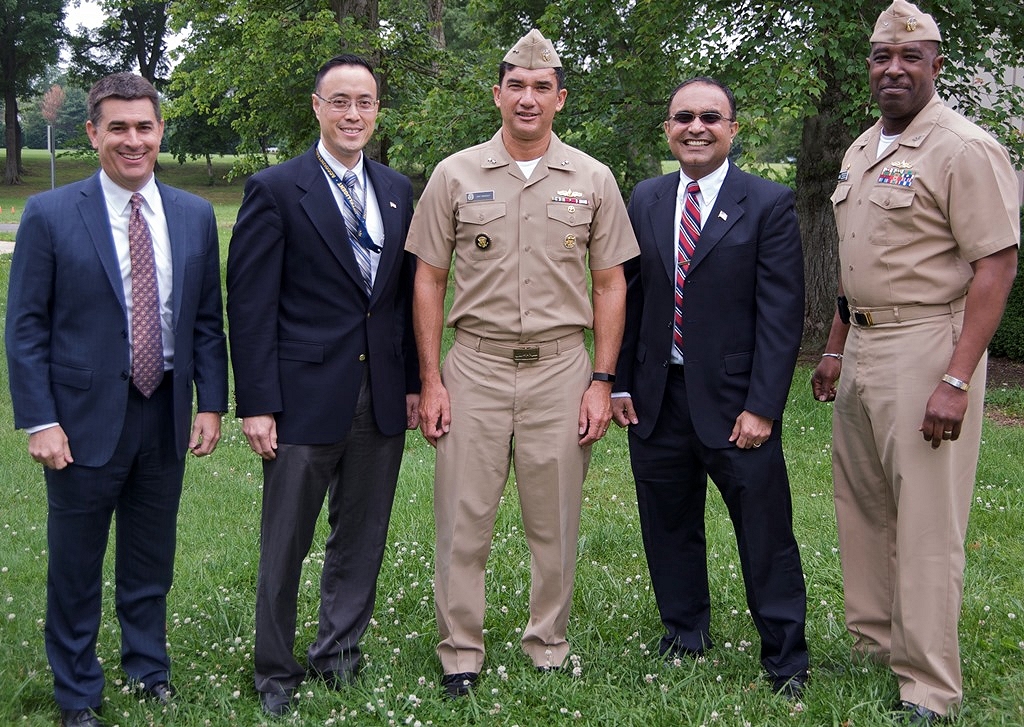DAHGLREN, Va. (June 07, 2017)—Rear Adm. Patrick Piercey looked forward to his tour of Navy directed energy, surface warfare, and cyber defense facilities but first he had two confessions to make.
"I knew nothing or close to nothing about my Filipino heritage while growing up and today, I regret it," said Piercey. "My second confession—in the very beginning, when I started filling out forms, I recorded myself as Caucasian."
The commander of Naval Surface Force Atlantic made his confessions before a packed house celebrating Asian American and Pacific Islander (AAPI) Heritage Month where he spoke about surface warfare strategy, his upbringing, and strength in diversity, May 23.
The admiral explained that he didn't want anything special, only to compete on his merits.
"Now at this age, I'm Asian Pacific Islander," said Piercey. "It's not a matter of pride one way or the other. My thinking has shifted as I've gotten older and hopefully wiser."
Piercey—who is half Filipino—grew up in western Oklahoma and Tulsa where there was no Filipino community, reminisced that he participated in his school's chess club, math club, and played soccer.
"My first exposure to the Filipino community was in the Norfolk area when I came out to the East coast for the first time," he said.
The admiral showed the audience family photos, including pictures of his mother who was a Filipino from Manila. His mother's family emigrated to Arkansas and as doctors, they worked in tuberculosis sanatoriums. Through an act of congress they were made permanent citizens, leading to their naturalization. His father's side of the family were ranchers and his grandfather was elected county commissioner.
The 2017 AAPI theme is "Unite Our Voices by Speaking Together" which encourages the various Asian American and Pacific Islander communities and other ethnic groups to join together to overcome misconceptions and stereotypes.
Piercey recounted a personal experience while he was the executive assistant for Adm. Harry Harris—son of a Navy chief petty officer and a Japanese postwar bride—who is currently the commander of U.S. Pacific Command.
At the time, Harris was assistant to the chairman, Joint Chiefs of Staff. Today, he is the senior most Asian Pacific Islander in the Department of Defense.
"We visited a Japanese American museum in Los Angeles and met with veterans from the 442nd regiment who fought honorably," said Piercey. "It was the most distinguished regiment in World War II, and we saw displays on the Japanese internment camps in World War II."
Most of the families of mainland Japanese Americans were confined to internment camps in the U.S. mainland throughout the war.
The Army's 442nd Regimental Combat Team comprised American soldiers of Japanese ancestry who fought primarily in Europe during World War II. The regiment was the most decorated unit for its size and length of service in the history of American warfare.
Moreover, 6,000 Nisei (second-generation Japanese Americans) served in the Military Intelligence Service, performing secret intelligence work against the Japanese military.
The admiral linked the stereotyping of groups based on ethnicity or religion to toxic behaviors and internment camps.
"It's hard to imagine us going back to internment camps," said Piercey. "I would never think that today in America we would have an environment and find ourselves in a situation where people are put in camps. Unfortunately, there's some feeling out there that could lead to that. The challenges and divisions that our nation faces within could lead to taking groups of people, stereotyping them and putting them in camps.
"So when the CNO (Chief of Naval Operations) talks about no bystanders and toxic behavior, that's where I've got to say—'no bystanders and no toxic behavior'. We as a nation are not definitely going down that path but boy, it's got to be squished as we continue to take action and say that we're not going back to those days".
Instead, Piercey emphasized that the Navy and nation will become stronger by celebrating differences without division.
"We are united by our love of freedom and love of the values that we have as Americans despite what source you came in to become an American," said Piercey. "We are celebrating diversity without being divisive and recognizing that we are truly stronger because of our diversity."
Piercey explained why he is so passionate about diversity.
"This is about our children, it's about our future," he said. "I think this is the challenge we have today in our nation. Everyone has dreams and what we need to do is to help enable everyone to have a chance to get to their dreams."
Surface Warfare Readiness, Strategy, and Technology
The admiral began his keynote speech by discussing his sense of urgency to guarantee the surface Navy is prepared for any fight today and in the future.
"You are all playing an absolutely crucial role in terms of making sure the surface force is ready for that fight," said Piercey. "The mindset is I what think is the most critical part here, so when I talk to my forces and when I talk to groups—I talk about August 1942."
Suddenly, the admiral asked the audience for a show of hands on who read 'Neptune's Inferno: The U.S. Navy at Guadalcanal' by James Hornfischer, recommending the book to those who have not read it.
"The first battle in the Guadalcanal campaign was the battle of Savo Island where we lost 1,077 Sailors," said Piercey about the battle considered by many to be the worst defeat in a fair fight in the history of the U.S. Navy.
Adm. Kelly Turner, chief of Naval Amphibious Forces in the Pacific, assessed that "we were lethargic of mind", said Piercey as he recounted Turner's after action report.
"We don't have the luxury today to say, "hey, I've got two or three years to get ready," or to figure out that I've got it wrong nine months into the fight," said Piercey. "It's going to happen too fast. We've got to be ready today, and it can't be just talk—there's got to be action. That's why I talk about the mindset part. For us in the surface community, we've got to be thinking about the sense of urgency. We've got to be ready, we've got to ask tough questions. That's why the return to sea control as our surface warfare strategy is really important, and you play an absolutely crucial role. I'm glad this is a large group of civilians because you are so important to our success as a nation."
During his tour, NSWCDD cyber engineers briefed Piercey on USS Secure—a multi-enclave test environment to enable the Navy's development, evaluation, and testing of cybersecurity concepts and technologies to defend mission critical systems at sea and ashore.
Navy civilian scientists and engineers updated Piercey on the command's directed energy programs, including high energy laser weapons such as the Laser Weapon System which operates aboard the USS Ponce (AFSB[I] 15) seamlessly with its ship defense system. They also briefed the admiral on a cybernetic laboratory called USS Dahlgren and its ability to evaluate a strike group's gun weapon systems, combat systems, and unmanned vehicles' interoperability with surface and air assets.
Prior to leaving for his tour and technical briefings, Piercey concluded his AAPI speech by reading a compelling excerpt from Martin Luther King's "I have a dream speech" made on the steps of the Lincoln Memorial to about 250,000 people attending a civil rights march on Aug. 28, 1963.
Confessions of an Admiral - Piercey Reflects on His Upbringing, U.S. History, and a Diverse Future

Rear Adm. Patrick Piercey, Naval Surface Force Atlantic commander, center, is pictured with Naval Surface Warfare Center Dahlgren Division (NSWCDD) leadership at the command's Asian American and Pacific Islander Heritage Month Observance. After his keynote speech, Piercey received technical briefings during a tour of NSWCDD facilities and laboratories dedicated to directed energy, surface warfare, and cybersecurity research, development, test and evaluation. Standing left to right: Dale Sisson, NSWCDD deputy technical director; Jim Yee, NSWCDD deputy department head for gun and electric weapon systems; Piercey; Gaurang Dävé, NSWCDD senior cyber technical advisor; and Capt. Gus Weekes, NSWCDD commanding officer. (U.S. Navy Photo by Patrick Dunn/Released)


